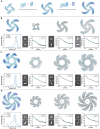This is a preprint.
Modulation of FGF pathway signaling and vascular differentiation using designed oligomeric assemblies
- PMID: 36993355
- PMCID: PMC10055045
- DOI: 10.1101/2023.03.14.532666
Modulation of FGF pathway signaling and vascular differentiation using designed oligomeric assemblies
Update in
-
Modulation of FGF pathway signaling and vascular differentiation using designed oligomeric assemblies.Cell. 2024 Jul 11;187(14):3726-3740.e43. doi: 10.1016/j.cell.2024.05.025. Epub 2024 Jun 10. Cell. 2024. PMID: 38861993 Free PMC article.
Abstract
Growth factors and cytokines signal by binding to the extracellular domains of their receptors and drive association and transphosphorylation of the receptor intracellular tyrosine kinase domains, initiating downstream signaling cascades. To enable systematic exploration of how receptor valency and geometry affects signaling outcomes, we designed cyclic homo-oligomers with up to 8 subunits using repeat protein building blocks that can be modularly extended. By incorporating a de novo designed fibroblast growth-factor receptor (FGFR) binding module into these scaffolds, we generated a series of synthetic signaling ligands that exhibit potent valency- and geometry-dependent Ca2+ release and MAPK pathway activation. The high specificity of the designed agonists reveal distinct roles for two FGFR splice variants in driving endothelial and mesenchymal cell fates during early vascular development. The ability to incorporate receptor binding domains and repeat extensions in a modular fashion makes our designed scaffolds broadly useful for probing and manipulating cellular signaling pathways.
Keywords: De novo protein design; FGF signaling; binder design; cryo-EM; endothelial cell differentiation; iPSCs; oligomeric scaffolds.
Conflict of interest statement
Competing interests The authors filed a patent application.
Figures





References
-
- Zhang K., Gao H., Deng R. & Li J. Emerging Applications of Nanotechnology for Controlling Cell-Surface Receptor Clustering. Angewandte Chemie - International Edition 58, 4790–4799 (2019). - PubMed
Publication types
Grants and funding
- P30 GM124169/GM/NIGMS NIH HHS/United States
- R01 AG063845/AG/NIA NIH HHS/United States
- S10 OD018483/OD/NIH HHS/United States
- U01 HL099993/HL/NHLBI NIH HHS/United States
- U01 HL099997/HL/NHLBI NIH HHS/United States
- U19 AG065156/AG/NIA NIH HHS/United States
- R01 GM097372/GM/NIGMS NIH HHS/United States
- R35 GM128777/GM/NIGMS NIH HHS/United States
- T90 DE021984/DE/NIDCR NIH HHS/United States
- R01 GM083867/GM/NIGMS NIH HHS/United States
- P01 GM081619/GM/NIGMS NIH HHS/United States
- U24 GM129539/GM/NIGMS NIH HHS/United States
LinkOut - more resources
Full Text Sources
Miscellaneous
